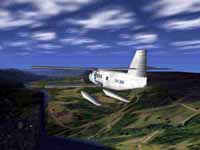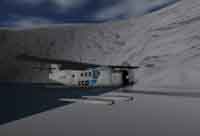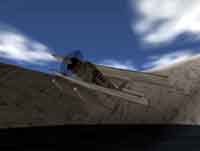|
THC 008 - Antonov AN-4 Colt
"Water pipe"
(Home base: LSZB, Switzerland. Chief pilot: Sir Hak "the seagul")
Neutrino Research in Kamensk
Nowosibirsk, january 6th 1993
Grigorij Doborgatsky was talking to the local officer in charge and it almost looked like we could get an agreement. Then the officer pointed with his flabby fingers to the backoffice door. This was obviously the mafia office - and even more obviously the real decisions were made there, and not at the official office. We entered the room, and Grigorij began to deal with the smart looking  small man behind the big desk. small man behind the big desk.
After almost an hour of explanations, the boss got interested in our project: neutrino research in the lake Baikal. I assume he did not understand much of our project, but all the fancy electronics in our cargo attracted his attention. We spent more than two hours stepping through the package list and explaining each and every part. Finally, after many reassurements that we have no valuables, no money and nothing else to spare, Grigorij managed to get the boss’s allowance to load our material into one of the waggons that will head for Irkutsk by tomorrow.
Our plan was to move the photomultiplier tubes, the 20 miles fibre optic cables and the piles of electronics to Irkutsk. We were a part of a neutrino research team that is going to install a neutrino detector deep below the surface of the Baikal sea.
Back in town, we went to the next food store and spent afterwards the last rubels for a few glasses Smirnov. The night was short and the morning unpleasantly bright. Nevertheless we joined the workers loading the train and observed the handling of our equippement. The train took of six hours late, but everybody was happy it took of at all.

When we arrived in Irkutsk, we unloaded the waggon into our transport truck, and old army truck. Next leg of our trip would be the “Baikal Train” route, an old part of the Trans-sibirian railway. The most expensive part of the whole Trans-sib was the part around Baikal sea. 90 tunnels over 45 miles railway track. After the building of a dam, part of the track was flooded and the part around the Baikal sea is now mostly unused. The one part that is still open is the “Baikal Train” route. But I’m diverging...
From Irkutsk we planned to move through Schelichon, Kultuk, Sludjanka, Wydrino, Babuschkin and finally reach Kamensk. There our troop was already preparing the four vehicles that will bring us and our equipement about 10 miles out to the frozen Baikal sea.
There we will brake a whole in the ice, install our neutrino detector (an array of 92 high pressure resistant glass bowls containing highly sensitive photomultiplier tubes) and sink the detector down to 1664m below surface.
 We arrived in Kamensk after a long journey in an old, rattling train, but it was worth the raw back - the trip was beautiful. In Kamensk, we had a little party with our team, and next morning we moved our caravan out to the Baikal ice layer. The ice was string enough to support us without showing signs of stress, nevertheless our lead driver and his ice expert collegue monitored the ice with cautious eyes. We arrived in Kamensk after a long journey in an old, rattling train, but it was worth the raw back - the trip was beautiful. In Kamensk, we had a little party with our team, and next morning we moved our caravan out to the Baikal ice layer. The ice was string enough to support us without showing signs of stress, nevertheless our lead driver and his ice expert collegue monitored the ice with cautious eyes.
We arrived by the late afternoon and our main task was to put up our camp, as it gets pretty damn cold out on the ice, in the night. It’s really a special feeling to sleep on a frozen lake... you gotta try this! Anyway, the next early morning we began building the detector while the ice experts begun to work on the whole. They used a hot water compressor to melt a small whole, then began to broaden the whole by laser beamers. This was nescessary to not crack the fragile layered structure of the ice and to therefore prevent the borders from showing fissures.
By the night we were ready to put the detector down. But we decided we better wait until next morning as it is dangerous in the region of the whole when sight is bad. During the night we slept all deeply as we were working pretty hard for more than 16 hours. But tomorrow, we thought, we can finally sink the detector and then begin to count neutrinos flying by and revealing characteristic Cherenkov sparks.
I awoke by a loud shouting, glancing at my watch: 05:15 AM. Damn, this
must be important at this hour! I got up and after putting on all my clothes I had lying around, I left my tent, looking around. Dammit! (sorry) Our camp was floating on an ice block, only a few feet wide ice bridge was left. When all were awake, we discussed the situation. The ice experts analysed the ice block and estiamted that there is no immediate danger, but we cannot move any hefty loads. So we decided to send one man for help, while the others secure the area as good as possible. But what sort of help? Noone can come near our camp without possibly brake our ice block! We found no good solution, until I proposed that I could maybe organise a sea plane. The worst case scenario was to attach all valuable instruments to empty oil drums, water tight packed. Then we could at least pick up some of the most expensive items, if things go worse and the ice breaks.
I escaped the frozen nightmare and walked the 10 miles back to Kamensk. There I got the information that in Ulan-Ude a military camp was hosting seaplanes. I managed to get to Ulan-Ude where it took me my watch, my knife and two bottles of Wodka to convince the responsible airfield officer that I need one of his planes for an emergency. After all, I got the permission and we made the plane ready: and Antonov AN-4 Colt. I took of from the river Uda and headed towards our camp on lake Baikal.
After a few minutes, I saw the camp, but decided to go around a few times to get a better feeling for the aircraft. I flew one low altitude bypass to check the area and saw a small but pretty long ice free area. The experts have done a great job! So, I prepared for touch down, full flaps, spedd as low as possible (around 68 kts), high AOA and pulling-pushing the stick to keep a straight flight path. Pchchch-schschschsch... the bird was down on his feets. I decided to kill the engine as I came near the camp’s ice block, so the vibrations might not force the ice to break. The threw me a tow and pulled me to the blocks border. The team then began to evacuate our most important equipement, while a small group and I tried to turn the aircraft around for take off.
The aircraft was loaded, and I prepared for take off. No flaps, full throttle and up we go. At least I expected this. The speed went up 35-40-45-50 knots, at 60 knots I threw in the flaps, but the bird was to heavy to lift off. Whohooo! The end of the ice free area came nearer and nearer in a frightening speed, while I was pulling the stick like a horse, constantly swearing “I’ll always keep you in a golden hangar next to my side if you now lift off your a** !” . And the fact that I am writing the story shows she finally did... The rest of the story is short: after a couple of successfull flight, we had saved all our equipements, except the vehicles. Then I remembered my swearing, and told this to my friends. All agreed that thanks to this aircraft our crew, our detector and our electronics have been saved. They agreed to sink all vehicles and tell the authorities that the aircraft was lost in the last flight, sunken with all other vehicles. Then followed a long, long low altitude VFR flight without filed flight plan... and now we have her in our dESPair hangar, my beloved “Water Pipe”.
.
Captain Habakuk
Hak the seagul
|
|
Facts & Info
The first
seaplane in the
dESPair fleet.
The THC008,Antonov
AN-4 Colt was our first
seaplane in the
fleet. Read the story
of the aircraft to
the left of this column.
Gallery
Have a look at the
picture gallery of
the Waterpipe!
Tech data
The THC008 has a max.
range of XXX nm and
we can cruise up to
XXXXX ft. The XX hp
Pratt&Whittney engines
accelerate the XXXXX lb
aircraft to about XXX kts.
A cabine length of about
XX ft provides space enough to transport
passengers and a fair
cargo load to almost
any wet spot on this
earth..
Contact chief pilot:
Capt. "seagul" Habakuk
habakuk@g-point.com
|